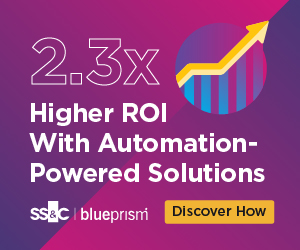
From Archimedes to Gutenberg to Ford to Jobs, technological advancements throughout existence have been applied to human labor to increase productivity and free up time and resources for other pursuits.
In the first decades of the 21st century, corporations are committing to digital transformation to leverage new technology in ways that can solve old problems. One of the oldest is how to apply human capital most efficiently and how to automate repetitive tasks, enabling companies to direct human intelligence toward more challenging problems that require creative problem solving.
Most recently, companies intent on digital transformation have identified robotic process automation (RPA) as a business technology that can have profound impacts on productivity, costs, efficiency, compliance and more.
[um_loggedin]
What Is Robotic Process Automation?
RPA is the advanced application of software designed to automate business processes. The software in question–the “robots” in robotic process automation–is able to replicate how a human would interact with a digital system to execute any of a vast array of tasks across an equally vast array of businesses. Using RPA robots, companies can capture and manipulate data, prompt appropriate responses and communicate with internal systems. Businesses are currently using RPA for tasks as simple as generating automatic responses to emails, batch data input, or even more complex–and usually manual–tasks like running credit checks.
Financial services firms–where the combination of high transaction volumes and increased regulation places a premium on an organization’s ability to streamline operations and ensure appropriate levels of control–were among the first to champion RPA. But insurance, telecom, retail, health care and energy are sectors where RPA deployments are increasingly common.
RPA grew out of IT automation, but it differs in a significant way. While traditional software can automate repetitive tasks under strict conditions, RPA’s use of artificial intelligence and machine learning enable it to handle higher order situations that require predictive analytics in variable conditions.
According to Gartner, spending on RPA will grow from around $680 million in 2018 to $2.4 billion in 2022. By that time, the consultancy predicts, 85 percent of large and very large organizations will have deployed some form of RPA.
“The growth in adoption will be driven by average RPA prices decreasing by approximately 10 percent to 15 percent by 2019, but also because organizations expect to achieve better business outcomes with the technology, such as reduced costs, increased accuracy and improved compliance,” said Gartner Vice President Cathy Tornbohm.
Benefits of RPA
Workers in nearly every business can struggle with inefficient technology that is either obsolete or not perfectly suited to the tasks they are responsible for. Many more who are engaged in mind-numbing, repetitive activities understand if a machine could do their work, it would free them up to accomplish more important work.
RPA is a perfect solution for either of these issues. Employees wasting their talent on low-level tasks can turn their attention to strategic, valuable, long-term tasks that require more creativity. Despite significant advances in AI and machine learning in recent years, computers still aren’t effective at activities that benefit from higher-level reasoning and emotional intelligence.
They are effective, though, at tackling gaps in efficiency and productivity that result from manual processes. Tasks that don’t require much human input to start with, those that pull data from multiple systems or sources, and others that require advanced accuracy are good places to start RPA implementations.
According to a McKinsey report, companies that implement RPA can see first-year ROI of 30 to 200 percent.
The most obvious benefits RPA will yield for businesses include improved accuracy, increased speed, lower costs and better compliance.
Humans make mistakes. In repetitive manual processes, that propensity is even more pronounced. Researchers at the University of Hawaii found that 88 percent of non-trivial spreadsheets contain errors. By removing humans from certain tasks, RPA can dramatically improve the accuracy of certain outputs. And not only are robots more accurate, they also can work far more quickly than any human employee.
Increased speed and accuracy naturally result in lower costs. And, by standardizing processes and with access to robust reporting, RPA makes compliance with all applicable laws and regulations simpler.
RPA’s Impact on Broader Business Strategies
RPA can be an important part of any organization’s digital transformation, and integrates well with other facets such as business process management (BPM). When used within a larger business strategy, RPA can eliminate redundancies and improve an organization’s ability to evaluate and refine its business processes. It is transformative in and of itself, but RPA is especially powerful when companies begin to understand how it meshes human employees, benefiting from the strengths of each and attenuating their weaknesses.
Digital transformation can be empty buzzwords that result in long and expensive system integrations without much improvement in actual results. RPA enables transformation at a faster pace and with less effort. Adding RPA to existing platforms and technologies is possible without having to rebuild an IT environment from the ground up.
[/um_loggedin]
[um_loggedout] [/um_loggedout]

